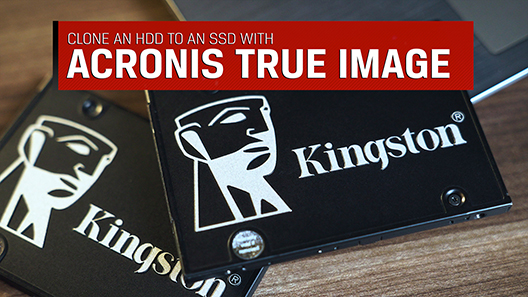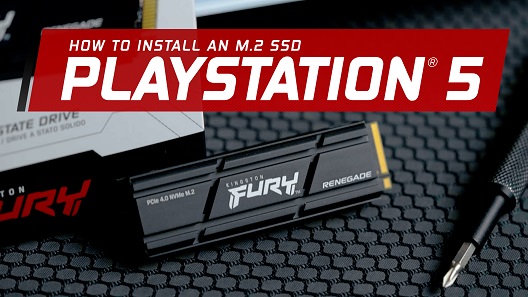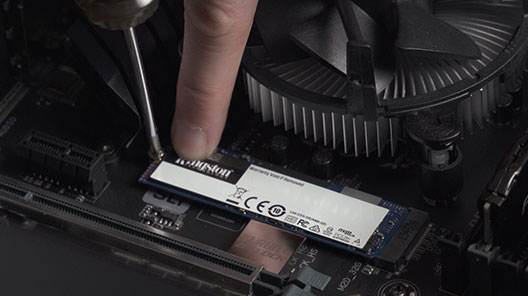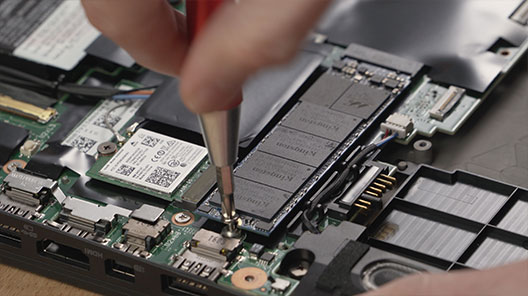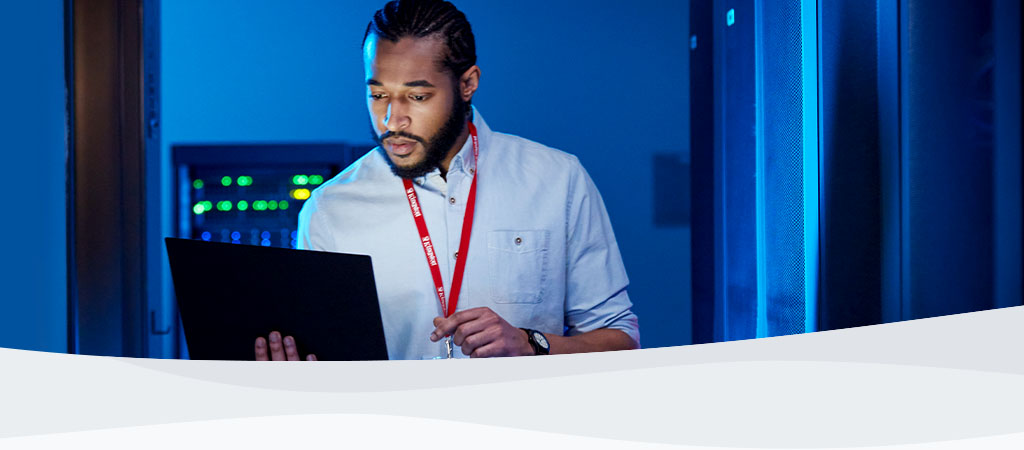
Kingston FURY Renegade PCIe 4.0 NVMe M.2 SSD - Dukungan
Sumber Daya
Video
Pertanyaan yang Sering Diajukan
FAQ: KSD-200100-FURY-001
Apakah ini membantu?
1. Unduh Kingston SSD Manager dari https://www.kingston.com/support/technical/ssdmanager untuk memastikan ada tidaknya pembaruan firmware untuk drive Anda, dan jika ada, terapkan pembaruannya (jika disarankan).
2. Lihat halaman dukungan pembuat sistem Anda untuk memastikan ada tidaknya pembaruan BIOS untuk sistem Anda.
3. Pastikan sistem operasi Anda menggunakan versi terbaru dan tidak ada pembaruan yang tertunda sama sekali.
4. Pastikan bahwa sistem Anda menggunakan driver terbaru. Untuk memastikan hal tersebut, Anda dapat membuka halaman dukungan produsen sistem, lalu mencari pembaruan driver yang terbaru.
Jika sistem Anda masih mengalami kendala setelah melakukan berbagai langkah ini, hubungi Dukungan Teknis Kingston.
FAQ: KSD-012010-001-21
Apakah ini membantu?
Hal ini umum terjadi pada penyimpanan flash, baik penyimpanan SSD internal atau USB eksternal, yang sebagiannya disebabkan oleh perbedaan dalam cara menghitung megabyte antara produsen memori flash vs produsen hard disk dengan piringan berputar. Produsen hard disk menghitung satu megabyte (atau 1.000x1.000 byte) sebagai 1.000KB, sedangkan perhitungan biner untuk penyimpanan berbasis flash adalah 1.024KB.
Contoh: Untuk perangkat penyimpanan berbasis flash 1TB, Windows akan menghitungnya sebagai berkapasitas 931,32GB. (1.000.000.000.000÷1.024÷1.024÷1.024=931,32GB).
Selain itu, Kingston mencadangkan sebagian dari kapasitas yang tercantum untuk pemformatan dan fungsi lainnya seperti firmware dan/atau informasi khusus pengontrol sehingga sebagian dari kapasitas yang tercantum tidak tersedia untuk penyimpanan data.
FAQ: KDT-010611-GEN-06
Apakah ini membantu?
FAQ: KSD-001525-001-00
Apakah ini membantu?
Ada beragam jenis enclosure eksternal yang tersedia di pasar. Meskipun Kingston selalu berupaya agar produknya kompatibel dengan semua jenis sistem, terkadang, masalah inkompatibilitas masih dapat terjadi.
Jika Anda mengalami kendala dengan enclosure SSD non-Kingston, hubungi Dukungan Teknis Kingston untuk mendapatkan bantuan pemecahan masalah.
FAQ: KSD-012010-001-18
Apakah ini membantu?
Tidak, Kingston tidak menyediakan kit peningkatan bundle NVMe.
FAQ: KSD-012010-001-30
Apakah ini membantu?
Lihat panduan kami: Menginstal SSD M.2
Perhatikan juga bahwa Anda mungkin perlu mengklonakan drive yang diganti. Lihat panduan kami tentang cara mengklonakan drive dengan perangkat lunak Acronis yang disertakan.
FAQ: KSD-012010-001-00
Apakah ini membantu?
Lihat panduan kami:
- Menginstal SSD M.2 di PlayStation® 5
- Tingkatkan Penyimpanan Internal PS5 Slim Anda dengan SSD Kingston FURY
FAQ: KSD-012010-001-01
Apakah ini membantu?
Jika hal tersebut tidak memungkinkan, atau jika sebelumnya Anda telah mengklonakan data lama Anda ke drive baru tersebut, pastikan bahwa drive baru tersebut muncul sebagai perangkat boot di BIOS sistem, lalu pilih drive tersebut untuk proses boot.
FAQ: KSD-012010-001-03
Apakah ini membantu?
-Pastikan bahwa BIOS sistem mengenali SSD baru Anda. Jika tidak, lihat di situs web produsen motherboard/sistem untuk mengetahui tersedia tidaknya BIOS yang baru.
-Verifikasikan bahwa pengaturan BIOS Anda sudah dikonfigurasi untuk dapat menerima SSD NVMe yang baru.
-Pastikan bahwa sistem operasi yang akan diinstal mendukung SSD NVMe (Contohnya: Windows 8 atau yang lebih baru)
Catatan: SSD Kingston tidak membutuhkan driver tambahan untuk berfungsi.
FAQ: KSD-012010-001-05
Apakah ini membantu?
Windows 7 secara bawaan tidak mendukung SSD NVMe. Lihat penjelasan hotfix Microsoft tentang penginstalan Windows 7 pada SSD NVMe.
FAQ: KSD-012010-001-06
Apakah ini membantu?
FAQ: KSD-012010-001-07
Apakah ini membantu?
Jika drive terlihat di BIOS, Anda mungkin perlu menginisialisasi disk dalam sistem operasi.
Untuk Windows:
Langkah 1: Pastikan bahwa drive telah dipasang dengan baik, lalu hidupkan sistem untuk melakukan boot ke Sistem Operasi Windows.
Langkah 2: Tekan tombol Windows + X, lalu pilih Manajemen Disk.
Langkah 3: Jika SSD masih baru dan belum diinisialisasi, jendela sembul akan muncul dengan pesan “Inisialisasi Disk”.
Langkah 4: Pilih antara:
MBR (Master Boot Record): Cocok untuk drive berkapasitas di bawah 2TB dan sistem operasi lama.
GPT (GUID Partition Table): Dianjurkan untuk sistem terbaru dan drive berkapasitas lebih dari 2TB.
Langkah 5: Klik OK untuk menginisialisasi disk.
Langkah 6: Setelah terinisialisasi, status SSD akan menjadi “Unallocated" (Tidak dialokasikan). Klik kanan pada disk, lalu pilih New Simple Volume (Volume Baru Biasa).
Langkah 7: Ikuti perintah di layar untuk memformat dan menetapkan huruf drive untuk SSD.
Untuk Mac OS:
Langkah 1: Pastikan drive terpasang dengan baik, hidupkan sistem, lalu boot ke Mac OS.
Langkah 2: Buka Utilitas Disk (dapat ditemukan dengan menggunakan Spotlight dengan tombol Cmd + spasi lalu mengetikkan “Disk Utility”).
Langkah 3: Di panel kiri, pilih SSD Anda.
Langkah 4: Klik Hapus.
Langkah 5: Berikan nama pada drive, lalu pada menu Format, pilih:
APFS untuk perangkat SSD dan Mac yang lebih baru.
Mac OS Extended (Journaled) untuk sistem atau HDD yang lebih lama.
Langkah 6: Klik Hapus. Setelah proses ini selesai, SSD akan siap digunakan.
Untuk Linux:
Langkah 1: Pastikan drive terpasang dengan baik, hidupkan sistem, lalu boot ke Linux OS.
Langkah 2: Buka terminal.
Langkah 3: Ketikkan perintah sudo fdisk -l untuk menampilkan semua drive yang terhubung. Identifikasikan SSD Anda dari ukurannya dan catat nama perangkatnya, mis., /dev/sdb.
Langkah 4: Lakukan inisialisasi SSD menggunakan perintah fdisk atau parted. Berikut panduan dasar penggunaan perintah fdisk:
Ketikkan perintah sudo fdisk /dev/sdb (ganti /dev/sdb dengan nama perangkat SSD Anda).
Tekan "g" untuk membuat tabel partisi GPT baru.
Tekan "n" untuk membuat partisi baru. Ikuti perintah untuk menentukan ukuran dan jenis.
Tekan "w" untuk mengonfirmasikan dan menyimpan perubahan ke disk.
Langkah 5: Format partisi baru pada SSD (mis., /dev/sdb1). Anda dapat memformatnya dengan menggunakan sistem file pilihan Anda:
Untuk ext4: sudo mkfs.ext4 /dev/sdb1
Untuk ext3: sudo mkfs.ext3 /dev/sdb1
Untuk FAT32: sudo mkfs.vfat /dev/sdb1
Langkah 6: Lakukan mount SSD:
Buat titik mount: sudo mkdir /mnt/myssd
Lakukan mount SSD: sudo mount /dev/sdb1 /mnt/myssd
Jangan lupa mengganti nama /dev/sdb1 dengan nama partisi SSD Anda.
FAQ: KSD-012010-001-15
Apakah ini membantu?
Bitte beachten Sie unsere Anleitung zur M.2-SSD-Technologie.
FAQ: KSD-012010-001-16
Apakah ini membantu?
FAQ: KSD-200100-FURY-001
Apakah ini membantu?
Firmware SSD adalah perangkat lunak yang terintegrasi dalam SSD untuk mengelola operasi SSD, termasuk komunikasi dengan sistem host, penyimpanan dan pengambilan data, perataan keausan, serta koreksi kesalahan.
Jika SSD memerlukan firmware baru, Anda akan menerima notifikasi saat menjalankan perangkat lunak Kingston SSD Manager.
FAQ: KSD-012010-001-11
Apakah ini membantu?
M.2 adalah faktor bentuk fisik. SATA dan PCIe merujuk pada antarmuka penyimpanan, perbedaan utamanya adalah kinerja dan protokol (bahasa) yang digunakan oleh SSD M.2 (misalnya, PCIe, SATA).
Spesifikasi M.2 dirancang untuk mengakomodasi antarmuka SATA dan PCIe untuk SSD. SSD M.2 SATA akan menggunakan pengontrol yang sama dengan pengontrol SSD SATA 2,5 inci biasa saat ini. SSD M.2 PCIe akan menggunakan pengontrol yang dirancang khusus untuk mendukung protokol PCIe. Meskipun setiap SSD M.2 hanya dapat mendukung satu protokol (misalnya, PCIe, SATA), sebagian sistem dapat memiliki soket M.2 yang mendukung PCIe dan SATA sekaligus. Periksa panduan pengguna sistem Anda untuk memastikan hal ini.
FAQ: KSD-004005-001-00
Apakah ini membantu?
Lihat panduan kami mengenai perbedaan antara drive solid state dan hard disk.
FAQ: KSD-012010-001-29
Apakah ini membantu?
Lihat panduan kami mengenai perbedaan antara SSD NVMe dan SSD SATA.
FAQ: KSD-012010-001-19
Apakah ini membantu?
Kingston menyarankan, apabila memungkinkan, perbarui firmware SSD Anda ke versi terbaru yang tersedia. Anda dapat memeriksa jika drive Anda sudah memiliki pembaruan yang tersedia dengan menggunakan perangkat lunak Kingston SSD Manager.
FAQ: KSD-012010-001-25
Apakah ini membantu?
Saat pengklonaan ke drive baru yang lebih besar dari drive sumber, perangkat lunak mungkin tidak menskalakan ukuran partisi dengan tepat. Jika hal ini terjadi, pengklonaan akan menghasilkan ruang penyimpanan yang tidak digunakan. Untuk menghindari hal tersebut, ikuti petunjuk pengklonaan berikut.
FAQ: KSD-012010-001-04
Apakah ini membantu?
Firmware SSD adalah perangkat lunak yang terintegrasi dalam SSD untuk mengelola operasi SSD, termasuk komunikasi dengan sistem host, penyimpanan dan pengambilan data, perataan keausan, serta koreksi kesalahan.
Jika SSD memerlukan firmware baru, Anda akan menerima notifikasi saat menjalankan perangkat lunak Kingston SSD Manager.
FAQ: KSD-012010-001-11
Apakah ini membantu?
FAQ: KSD-012010-001-12
Apakah ini membantu?
FAQ: KSD-012010-001-13
Apakah ini membantu?
FAQ: KSD-012010-001-14
Apakah ini membantu?
Saat pengklonaan ke drive baru yang lebih besar dari drive sumber, perangkat lunak mungkin tidak menskalakan ukuran partisi dengan tepat. Jika hal ini terjadi, pengklonaan akan menghasilkan ruang penyimpanan yang tidak digunakan. Untuk menghindari hal tersebut, ikuti petunjuk pengklonaan berikut.
FAQ: KSD-012010-001-04
Apakah ini membantu?
-Pastikan bahwa BIOS sistem mengenali SSD baru Anda. Jika tidak, lihat di situs web produsen motherboard/sistem untuk mengetahui tersedia tidaknya BIOS yang baru.
-Verifikasikan bahwa pengaturan BIOS Anda sudah dikonfigurasi untuk dapat menerima SSD NVMe yang baru.
-Pastikan bahwa sistem operasi yang akan diinstal mendukung SSD NVMe (Contohnya: Windows 8 atau yang lebih baru)
Catatan: SSD Kingston tidak membutuhkan driver tambahan untuk berfungsi.
FAQ: KSD-012010-001-05
Apakah ini membantu?
Bitte beachten Sie unsere Anleitung zur M.2-SSD-Technologie.
FAQ: KSD-012010-001-16
Apakah ini membantu?
Jika drive terlihat di BIOS, Anda mungkin perlu menginisialisasi disk dalam sistem operasi.
Untuk Windows:
Langkah 1: Pastikan bahwa drive telah dipasang dengan baik, lalu hidupkan sistem untuk melakukan boot ke Sistem Operasi Windows.
Langkah 2: Tekan tombol Windows + X, lalu pilih Manajemen Disk.
Langkah 3: Jika SSD masih baru dan belum diinisialisasi, jendela sembul akan muncul dengan pesan “Inisialisasi Disk”.
Langkah 4: Pilih antara:
MBR (Master Boot Record): Cocok untuk drive berkapasitas di bawah 2TB dan sistem operasi lama.
GPT (GUID Partition Table): Dianjurkan untuk sistem terbaru dan drive berkapasitas lebih dari 2TB.
Langkah 5: Klik OK untuk menginisialisasi disk.
Langkah 6: Setelah terinisialisasi, status SSD akan menjadi “Unallocated" (Tidak dialokasikan). Klik kanan pada disk, lalu pilih New Simple Volume (Volume Baru Biasa).
Langkah 7: Ikuti perintah di layar untuk memformat dan menetapkan huruf drive untuk SSD.
Untuk Mac OS:
Langkah 1: Pastikan drive terpasang dengan baik, hidupkan sistem, lalu boot ke Mac OS.
Langkah 2: Buka Utilitas Disk (dapat ditemukan dengan menggunakan Spotlight dengan tombol Cmd + spasi lalu mengetikkan “Disk Utility”).
Langkah 3: Di panel kiri, pilih SSD Anda.
Langkah 4: Klik Hapus.
Langkah 5: Berikan nama pada drive, lalu pada menu Format, pilih:
APFS untuk perangkat SSD dan Mac yang lebih baru.
Mac OS Extended (Journaled) untuk sistem atau HDD yang lebih lama.
Langkah 6: Klik Hapus. Setelah proses ini selesai, SSD akan siap digunakan.
Untuk Linux:
Langkah 1: Pastikan drive terpasang dengan baik, hidupkan sistem, lalu boot ke Linux OS.
Langkah 2: Buka terminal.
Langkah 3: Ketikkan perintah sudo fdisk -l untuk menampilkan semua drive yang terhubung. Identifikasikan SSD Anda dari ukurannya dan catat nama perangkatnya, mis., /dev/sdb.
Langkah 4: Lakukan inisialisasi SSD menggunakan perintah fdisk atau parted. Berikut panduan dasar penggunaan perintah fdisk:
Ketikkan perintah sudo fdisk /dev/sdb (ganti /dev/sdb dengan nama perangkat SSD Anda).
Tekan "g" untuk membuat tabel partisi GPT baru.
Tekan "n" untuk membuat partisi baru. Ikuti perintah untuk menentukan ukuran dan jenis.
Tekan "w" untuk mengonfirmasikan dan menyimpan perubahan ke disk.
Langkah 5: Format partisi baru pada SSD (mis., /dev/sdb1). Anda dapat memformatnya dengan menggunakan sistem file pilihan Anda:
Untuk ext4: sudo mkfs.ext4 /dev/sdb1
Untuk ext3: sudo mkfs.ext3 /dev/sdb1
Untuk FAT32: sudo mkfs.vfat /dev/sdb1
Langkah 6: Lakukan mount SSD:
Buat titik mount: sudo mkdir /mnt/myssd
Lakukan mount SSD: sudo mount /dev/sdb1 /mnt/myssd
Jangan lupa mengganti nama /dev/sdb1 dengan nama partisi SSD Anda.
FAQ: KSD-012010-001-15
Apakah ini membantu?
Ada beragam jenis enclosure eksternal yang tersedia di pasar. Meskipun Kingston selalu berupaya agar produknya kompatibel dengan semua jenis sistem, terkadang, masalah inkompatibilitas masih dapat terjadi.
Jika Anda mengalami kendala dengan enclosure SSD non-Kingston, hubungi Dukungan Teknis Kingston untuk mendapatkan bantuan pemecahan masalah.
FAQ: KSD-012010-001-18
Apakah ini membantu?
Saat pengklonaan ke drive baru yang lebih besar dari drive sumber, perangkat lunak mungkin tidak menskalakan ukuran partisi dengan tepat. Jika hal ini terjadi, pengklonaan akan menghasilkan ruang penyimpanan yang tidak digunakan. Untuk menghindari hal tersebut, ikuti petunjuk pengklonaan berikut.
FAQ: KSD-012010-001-04
Apakah ini membantu?
Lihat panduan kami: Menginstal SSD M.2
Perhatikan juga bahwa Anda mungkin perlu mengklonakan drive yang diganti. Lihat panduan kami tentang cara mengklonakan drive dengan perangkat lunak Acronis yang disertakan.
FAQ: KSD-012010-001-00
Apakah ini membantu?
-Pastikan bahwa BIOS sistem mengenali SSD baru Anda. Jika tidak, lihat di situs web produsen motherboard/sistem untuk mengetahui tersedia tidaknya BIOS yang baru.
-Verifikasikan bahwa pengaturan BIOS Anda sudah dikonfigurasi untuk dapat menerima SSD NVMe yang baru.
-Pastikan bahwa sistem operasi yang akan diinstal mendukung SSD NVMe (Contohnya: Windows 8 atau yang lebih baru)
Catatan: SSD Kingston tidak membutuhkan driver tambahan untuk berfungsi.
FAQ: KSD-012010-001-05
Apakah ini membantu?
Jika hal tersebut tidak memungkinkan, atau jika sebelumnya Anda telah mengklonakan data lama Anda ke drive baru tersebut, pastikan bahwa drive baru tersebut muncul sebagai perangkat boot di BIOS sistem, lalu pilih drive tersebut untuk proses boot.
FAQ: KSD-012010-001-03
Apakah ini membantu?
Lihat panduan kami:
- Menginstal SSD M.2 di PlayStation® 5
- Tingkatkan Penyimpanan Internal PS5 Slim Anda dengan SSD Kingston FURY
FAQ: KSD-012010-001-01
Apakah ini membantu?
Jika drive terlihat di BIOS, Anda mungkin perlu menginisialisasi disk dalam sistem operasi.
Untuk Windows:
Langkah 1: Pastikan bahwa drive telah dipasang dengan baik, lalu hidupkan sistem untuk melakukan boot ke Sistem Operasi Windows.
Langkah 2: Tekan tombol Windows + X, lalu pilih Manajemen Disk.
Langkah 3: Jika SSD masih baru dan belum diinisialisasi, jendela sembul akan muncul dengan pesan “Inisialisasi Disk”.
Langkah 4: Pilih antara:
MBR (Master Boot Record): Cocok untuk drive berkapasitas di bawah 2TB dan sistem operasi lama.
GPT (GUID Partition Table): Dianjurkan untuk sistem terbaru dan drive berkapasitas lebih dari 2TB.
Langkah 5: Klik OK untuk menginisialisasi disk.
Langkah 6: Setelah terinisialisasi, status SSD akan menjadi “Unallocated" (Tidak dialokasikan). Klik kanan pada disk, lalu pilih New Simple Volume (Volume Baru Biasa).
Langkah 7: Ikuti perintah di layar untuk memformat dan menetapkan huruf drive untuk SSD.
Untuk Mac OS:
Langkah 1: Pastikan drive terpasang dengan baik, hidupkan sistem, lalu boot ke Mac OS.
Langkah 2: Buka Utilitas Disk (dapat ditemukan dengan menggunakan Spotlight dengan tombol Cmd + spasi lalu mengetikkan “Disk Utility”).
Langkah 3: Di panel kiri, pilih SSD Anda.
Langkah 4: Klik Hapus.
Langkah 5: Berikan nama pada drive, lalu pada menu Format, pilih:
APFS untuk perangkat SSD dan Mac yang lebih baru.
Mac OS Extended (Journaled) untuk sistem atau HDD yang lebih lama.
Langkah 6: Klik Hapus. Setelah proses ini selesai, SSD akan siap digunakan.
Untuk Linux:
Langkah 1: Pastikan drive terpasang dengan baik, hidupkan sistem, lalu boot ke Linux OS.
Langkah 2: Buka terminal.
Langkah 3: Ketikkan perintah sudo fdisk -l untuk menampilkan semua drive yang terhubung. Identifikasikan SSD Anda dari ukurannya dan catat nama perangkatnya, mis., /dev/sdb.
Langkah 4: Lakukan inisialisasi SSD menggunakan perintah fdisk atau parted. Berikut panduan dasar penggunaan perintah fdisk:
Ketikkan perintah sudo fdisk /dev/sdb (ganti /dev/sdb dengan nama perangkat SSD Anda).
Tekan "g" untuk membuat tabel partisi GPT baru.
Tekan "n" untuk membuat partisi baru. Ikuti perintah untuk menentukan ukuran dan jenis.
Tekan "w" untuk mengonfirmasikan dan menyimpan perubahan ke disk.
Langkah 5: Format partisi baru pada SSD (mis., /dev/sdb1). Anda dapat memformatnya dengan menggunakan sistem file pilihan Anda:
Untuk ext4: sudo mkfs.ext4 /dev/sdb1
Untuk ext3: sudo mkfs.ext3 /dev/sdb1
Untuk FAT32: sudo mkfs.vfat /dev/sdb1
Langkah 6: Lakukan mount SSD:
Buat titik mount: sudo mkdir /mnt/myssd
Lakukan mount SSD: sudo mount /dev/sdb1 /mnt/myssd
Jangan lupa mengganti nama /dev/sdb1 dengan nama partisi SSD Anda.
FAQ: KSD-012010-001-15
Apakah ini membantu?
Bitte beachten Sie unsere Anleitung zur M.2-SSD-Technologie.
FAQ: KSD-012010-001-16
Apakah ini membantu?
FAQ: KSD-012010-001-14
Apakah ini membantu?
FAQ: KSD-012010-001-13
Apakah ini membantu?
FAQ: KSD-012010-001-12
Apakah ini membantu?
Firmware SSD adalah perangkat lunak yang terintegrasi dalam SSD untuk mengelola operasi SSD, termasuk komunikasi dengan sistem host, penyimpanan dan pengambilan data, perataan keausan, serta koreksi kesalahan.
Jika SSD memerlukan firmware baru, Anda akan menerima notifikasi saat menjalankan perangkat lunak Kingston SSD Manager.
FAQ: KSD-012010-001-11
Apakah ini membantu?
FAQ: KSD-012010-001-07
Apakah ini membantu?
Windows 7 secara bawaan tidak mendukung SSD NVMe. Lihat penjelasan hotfix Microsoft tentang penginstalan Windows 7 pada SSD NVMe.
FAQ: KSD-012010-001-06
Apakah ini membantu?
Ada beragam jenis enclosure eksternal yang tersedia di pasar. Meskipun Kingston selalu berupaya agar produknya kompatibel dengan semua jenis sistem, terkadang, masalah inkompatibilitas masih dapat terjadi.
Jika Anda mengalami kendala dengan enclosure SSD non-Kingston, hubungi Dukungan Teknis Kingston untuk mendapatkan bantuan pemecahan masalah.
FAQ: KSD-012010-001-18
Apakah ini membantu?
